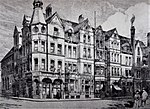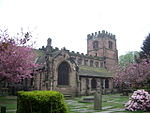Cheadle and Marple Sixth Form College
1946 establishments in EnglandBuildings and structures in the Metropolitan Borough of StockportEducation in the Metropolitan Borough of StockportEducational institutions established in 1946EngvarB from April 2019 ... and 1 more
Sixth form colleges in Greater Manchester

Cheadle and Marple Sixth Form College is a training provider for the Stockport (Greater Manchester) area specialising in 16–19 educational provision. It consists of two colleges, The Cheadle College and Marple Sixth Form College, which have a combined student population of nearly 2,000.
Excerpt from the Wikipedia article Cheadle and Marple Sixth Form College (License: CC BY-SA 3.0, Authors, Images).Cheadle and Marple Sixth Form College
West Downs Road,
Geographical coordinates (GPS) Address External links Nearby Places Show on map
Geographical coordinates (GPS)
| Latitude | Longitude |
|---|---|
| N 53.382 ° | E -2.203 ° |
Address
The Cheadle College
West Downs Road
SK8 5ER
England, United Kingdom
Open on Google Maps







